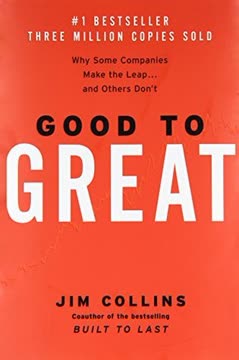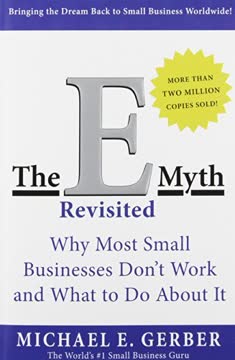Key Takeaways
1. The Law of the Few: Connectors, Mavens, and Salesmen drive social epidemics
"The success of any kind of social epidemic is heavily dependent on the involvement of people with a particular and rare set of social gifts."
Connectors are people with an extraordinary knack for making friends and acquaintances. They act as social hubs, bridging different worlds and spreading ideas rapidly. Mavens are information specialists who accumulate knowledge and share it with others. They are trusted experts who solve other people's problems by solving their own. Salesmen are charismatic persuaders with powerful negotiation skills. They have an indefinable trait that goes beyond what they say, making people want to agree with them.
These three types of people play crucial roles in starting word-of-mouth epidemics:
- Connectors: Know lots of people across various social circles
- Mavens: Provide the message and information
- Salesmen: Possess the skills to persuade us when we're unconvinced
Examples:
- Paul Revere was a Connector, which explains why his midnight ride was so effective in warning colonists about the British invasion
- Mark Alpert, a "Market Maven," has an almost obsessive knowledge of products and prices, which he eagerly shares with others
- Tom Gau, a successful financial planner, embodies the Salesman archetype with his natural ability to build trust and rapport quickly
2. The Stickiness Factor: Small changes can make messages more memorable and impactful
"There is a simple way to package information that, under the right circumstances, can make it irresistible. All you have to do is find it."
Subtle changes in the presentation of information can have a significant impact on its stickiness. This principle is demonstrated through various examples, showing how small adjustments can make a message more memorable and actionable.
Key examples of the Stickiness Factor:
- Sesame Street: Discovered that combining Muppets with human characters made the educational content more engaging for children
- Blue's Clues: Repeated the same episode for five days straight, allowing children to learn through repetition
- Anti-tetanus campaign: Adding a map with the locations and times of vaccinations dramatically increased participation
Techniques to increase stickiness:
- Use vivid, concrete language
- Create unexpected or surprising elements
- Appeal to emotions
- Provide practical value
- Tell stories that resonate with the audience
- Repeat key information in different ways
3. The Power of Context: Environment shapes behavior more than we realize
"Epidemics are sensitive to the conditions and circumstances of the times and places in which they occur."
Environmental factors play a crucial role in shaping human behavior, often more significantly than individual personality traits. This concept challenges the common belief that actions are primarily determined by personal characteristics.
Key examples illustrating the Power of Context:
- New York City crime reduction: Fixing broken windows and cleaning up graffiti led to a significant decrease in crime rates
- Stanford Prison Experiment: Ordinary people adopted cruel behaviors when placed in a simulated prison environment
- Good Samaritan study: Seminary students were less likely to help someone in distress when they were in a hurry
Implications of the Power of Context:
- Small changes in the environment can have large effects on behavior
- Social problems can often be addressed by altering the immediate context
- Understanding context can help predict and influence group behavior
- Personal character may be less fixed and more situational than we assume
4. Tipping Points occur when ideas, trends, or behaviors cross a threshold and spread rapidly
"The tipping point is that magic moment when an idea, trend, or social behavior crosses a threshold, tips, and spreads like wildfire."
Tipping Points are the moments when a gradual change suddenly becomes a dramatic and rapid transformation. This concept applies to various phenomena, from fashion trends to crime rates to the spread of diseases.
Characteristics of Tipping Points:
- Contagiousness: Ideas or behaviors spread like viruses
- Little causes have big effects: Small changes can lead to large-scale shifts
- Changes happen dramatically, not gradually
Examples of Tipping Points:
- Hush Puppies shoes: Went from near-extinction to a major fashion trend
- New York City crime rate: Dropped dramatically in the 1990s after years of steady increase
- Micronesian suicide epidemic: Spread rapidly among teenagers due to social contagion
Understanding Tipping Points can help:
- Identify early signs of emerging trends
- Create strategies to initiate or prevent social epidemics
- Recognize the potential for rapid, unexpected changes in various fields
5. Word-of-mouth epidemics follow specific patterns and can be deliberately initiated
"Ideas and products and messages and behaviors spread just like viruses do."
Word-of-mouth epidemics are not random occurrences but follow predictable patterns that can be studied and replicated. By understanding these patterns, it's possible to intentionally create and spread ideas or products.
Key components of word-of-mouth epidemics:
- The right people (Connectors, Mavens, Salesmen)
- A sticky message
- The right context
Strategies for initiating word-of-mouth epidemics:
- Identify and engage key influencers in your target community
- Craft a message that is memorable and easily shareable
- Create opportunities for people to experience and share your idea or product
- Leverage social proof and peer influence
- Use multiple channels to reinforce the message
Examples of successful word-of-mouth campaigns:
- Airwalk shoes: Used targeted advertising based on emerging trends
- Hotmail: Added "Get your free email at Hotmail" to every sent message
- The Blair Witch Project: Created buzz through mysterious online marketing
6. The Rule of 150 limits the size of effective social groups and organizations
"The Rule of 150 suggests that the size of a group is another one of those subtle contextual factors that can make a big difference."
Group dynamics change significantly when the number of people exceeds about 150. This number, known as Dunbar's number, represents the cognitive limit to the number of people with whom one can maintain stable social relationships.
Implications of the Rule of 150:
- Optimal group size for effective communication and cohesion
- Beyond 150, additional rules and structures are needed to maintain order
- Applies to various contexts: military units, religious groups, businesses
Examples of the Rule of 150 in action:
- Hutterite communities: Split into two when they approach 150 members
- Gore Associates: Limits its factories to 150 employees for optimal productivity
- Military companies: Typically organized into units of around 150 soldiers
Strategies for applying the Rule of 150:
- Break larger organizations into smaller, more manageable units
- Foster personal connections within groups
- Use technology to maintain relationships beyond the 150-person limit
- Be aware of the potential for decreased effectiveness as groups grow larger
7. To create change, focus resources on key areas rather than trying to solve everything at once
"The Tipping Point is the biography of an idea, and the idea is very simple. It is that the best way to understand the emergence of fashion trends, the ebb and flow of crime waves, or, for that matter, the transformation of unknown books into bestsellers, or the rise of teenage smoking, or the phenomena of word of mouth, or any number of the other mysterious changes that mark everyday life is to think of them as epidemics. Ideas and products and messages and behaviors spread just like viruses do."
Targeted interventions can be more effective than broad, unfocused efforts in creating significant change. This approach involves identifying and concentrating on the key factors that can tip a situation.
Principles for focused change:
- Identify the critical few factors that can create a tipping point
- Concentrate resources on these key areas
- Look for small changes that can have big effects
- Be willing to try unconventional or counterintuitive approaches
Examples of successful focused interventions:
- Reducing crime in New York City by focusing on minor offenses and "broken windows"
- Improving children's educational TV shows by making small changes to increase stickiness
- Combating teen smoking by addressing depression and nicotine thresholds
Strategies for implementing focused change:
- Conduct thorough research to identify key leverage points
- Test and refine interventions on a small scale before scaling up
- Be prepared to challenge conventional wisdom and existing practices
- Monitor results closely and be willing to adjust strategies as needed
8. Human behavior is more volatile and susceptible to influence than we often assume
"We are actually powerfully influenced by our surroundings, our immediate context, and the personalities of those around us."
Human behavior is often more influenced by external factors and immediate context than by inherent personality traits or long-held beliefs. This understanding challenges our assumptions about the consistency of human character and the difficulty of changing behavior.
Factors that influence behavior:
- Immediate physical environment
- Social context and peer pressure
- Subtle cues and suggestions
- Emotional states and moods
- Recent experiences and priming
Examples of behavioral volatility:
- The Stanford Prison Experiment: Ordinary students quickly adopted cruel behaviors in a simulated prison environment
- The Good Samaritan Study: Seminary students were less likely to help someone in distress when they were in a hurry
- The Broken Windows Theory: Minor signs of disorder in a neighborhood can lead to increased crime
Implications:
- Behavior change may be easier to achieve than commonly thought
- Environmental and contextual changes can be powerful tools for influencing behavior
- We should be cautious about attributing behavior solely to personality or character
9. Social epidemics can be positive or negative, from fashion trends to crime waves
"If you want to bring a fundamental change in people's belief and behavior...you need to create a community around them, where those new beliefs can be practiced and expressed and nurtured."
Social epidemics can manifest in various forms, both beneficial and harmful to society. Understanding the mechanics of these epidemics can help promote positive changes and mitigate negative ones.
Types of social epidemics:
- Fashion trends and fads
- Health behaviors (e.g., smoking, exercise habits)
- Crime waves
- Political movements
- Technological adoption
- Cultural phenomena
Characteristics of social epidemics:
- Contagiousness
- Small causes have big effects
- Dramatic and rapid change once a tipping point is reached
Examples of social epidemics:
- Positive: The rapid adoption of recycling habits
- Negative: The spread of teenage smoking
- Neutral: The sudden popularity of a new dance craze
Strategies for managing social epidemics:
- Identify and engage key influencers (Connectors, Mavens, Salesmen)
- Create sticky messages that resonate with the target audience
- Manipulate the context to encourage desired behaviors
- Be aware of potential unintended consequences
10. Understanding Tipping Points allows us to effect meaningful change with minimal resources
"Look at the world around you. It may seem like an immovable, implacable place. It is not. With the slightest push—in just the right place—it can be tipped."
Leveraging Tipping Points can help individuals and organizations create significant impact with limited resources. By understanding the principles of social epidemics, we can identify key leverage points and initiate positive change more effectively.
Key strategies for creating change through Tipping Points:
- Focus on the vital few: Identify and engage Connectors, Mavens, and Salesmen
- Make your message stick: Craft memorable and impactful content
- Manipulate the context: Create an environment conducive to your desired change
- Start small: Look for opportunities to create a ripple effect
- Be patient: Changes may seem slow at first, but can accelerate rapidly once a tipping point is reached
Examples of successful Tipping Point interventions:
- The "broken windows" theory applied to reduce crime in New York City
- The use of peer educators to promote safe sex practices in high-risk communities
- Viral marketing campaigns that leverage social networks to spread product awareness
Potential applications:
- Public health initiatives
Last updated:
FAQ
What's "The Tipping Point" about?
- Concept of Tipping Points: "The Tipping Point" by Malcolm Gladwell explores how small actions at the right time, in the right place, and with the right people can create a tipping point for change.
- Three Rules of Epidemics: The book introduces three rules of epidemics: the Law of the Few, the Stickiness Factor, and the Power of Context, which explain how trends spread.
- Diverse Examples: Gladwell uses examples from fashion, crime, and public health to illustrate how these principles apply to various social phenomena.
Why should I read "The Tipping Point"?
- Understanding Social Change: The book provides insights into how small changes can lead to significant social transformations, valuable for marketing, sociology, or psychology enthusiasts.
- Practical Applications: It offers practical advice on creating and controlling social epidemics, useful for business leaders, educators, and policymakers.
- Engaging Storytelling: Gladwell's engaging writing style and use of real-world examples make complex theories accessible and interesting.
What are the key takeaways of "The Tipping Point"?
- Law of the Few: A small number of people, known as Connectors, Mavens, and Salesmen, play a crucial role in spreading ideas and trends.
- Stickiness Factor: For an idea to spread, it must be memorable and impactful, which can be achieved through small but significant changes in presentation.
- Power of Context: The environment and circumstances play a critical role in tipping social epidemics, as demonstrated by the Broken Windows theory in crime reduction.
What is the Law of the Few in "The Tipping Point"?
- Key Influencers: The Law of the Few suggests that a small number of people with unique social gifts are responsible for the spread of ideas and trends.
- Connectors, Mavens, Salesmen: These individuals are categorized as Connectors (who know many people), Mavens (who accumulate knowledge), and Salesmen (who persuade others).
- Social Epidemics: These people are crucial in starting social epidemics because they have the ability to reach and influence a large number of people.
What is the Stickiness Factor in "The Tipping Point"?
- Memorable Messages: The Stickiness Factor refers to the quality of a message that makes it memorable and capable of creating change.
- Small Changes, Big Impact: Small adjustments in how information is presented can significantly enhance its stickiness, as seen in the success of "Sesame Street" and "Blue’s Clues."
- Practical Examples: The book illustrates this concept with examples like the gold box in direct marketing and the map in the tetanus shot study.
What is the Power of Context in "The Tipping Point"?
- Environmental Influence: The Power of Context emphasizes that human behavior is sensitive to and strongly influenced by environmental factors.
- Crime Reduction Example: The Broken Windows theory demonstrates how addressing minor crimes and signs of disorder can lead to a significant reduction in serious crime.
- Epidemic Tipping: Contextual changes, even small ones, can tip an epidemic, as seen in the dramatic drop in New York City crime rates in the 1990s.
How does "The Tipping Point" explain crime reduction in New York City?
- Broken Windows Theory: The book attributes the decline in crime to the application of the Broken Windows theory, which focuses on maintaining order and addressing minor offenses.
- Subway System Cleanup: Initiatives like cleaning graffiti and cracking down on fare evasion helped change the environment and reduce crime.
- Contextual Tipping: These efforts created a tipping point by altering the context in which crime occurred, leading to a broader decline in criminal behavior.
How does "The Tipping Point" relate to marketing and business?
- Understanding Consumer Behavior: The book provides insights into how trends spread, which is valuable for marketers looking to create viral campaigns.
- Influence of Key Individuals: Identifying and leveraging Connectors, Mavens, and Salesmen can help businesses reach a wider audience and increase their impact.
- Enhancing Stickiness: By making small changes to how products or messages are presented, businesses can increase their stickiness and improve customer engagement.
How can I apply the concepts from "The Tipping Point" in my own life?
- Identify Key Influencers: Recognize the Connectors, Mavens, and Salesmen in your network and leverage their influence to spread your ideas or products.
- Focus on Stickiness: Make your messages memorable and impactful by paying attention to how they are presented and received.
- Consider the Context: Be aware of the environmental factors that may influence behavior and look for ways to create a context that supports your goals.
What are some examples from "The Tipping Point"?
- Hush Puppies Revival: The resurgence of Hush Puppies shoes in the mid-1990s is an example of a tipping point, driven by a few influential people in the fashion industry.
- New York City Crime Drop: The dramatic decline in crime in New York City during the 1990s is attributed to small changes in policing and the environment, illustrating the Power of Context.
- Sesame Street's Success: The show's ability to educate children effectively is an example of the Stickiness Factor, where the content was crafted to be engaging and memorable.
What are the best quotes from "The Tipping Point" and what do they mean?
- "The Tipping Point is the biography of an idea": This quote encapsulates the book's exploration of how small changes can lead to significant social transformations.
- "Ideas and products and messages and behaviors spread just like viruses do": Gladwell draws a parallel between social epidemics and viral infections, emphasizing the contagious nature of trends.
- "The Power of Context says that human beings are a lot more sensitive to their environment than they may seem": This highlights the importance of environmental factors in shaping human behavior and tipping social epidemics.
How does "The Tipping Point" explain social epidemics?
- Combination of Factors: Social epidemics occur when the right combination of people, message, and context come together to create a tipping point.
- Role of Key Individuals: Connectors, Mavens, and Salesmen play a crucial role in spreading ideas and behaviors, acting as catalysts for change.
- Importance of Context and Stickiness: The environment and the stickiness of the message are equally important in determining whether an idea will tip into a widespread phenomenon.
Review Summary
The Tipping Point explores how ideas and trends spread like epidemics, focusing on three key factors: the law of the few, the stickiness factor, and the power of context. Readers found Gladwell's writing style engaging and his examples fascinating, though some criticized his reliance on anecdotes and loose interpretation of research. The book's concepts resonated with many, particularly in marketing and social sciences. While some found it groundbreaking, others felt the ideas were obvious or oversimplified. Overall, it remains a thought-provoking and influential work that sparked widespread discussion.
Similar Books










Download PDF
Download EPUB
.epub digital book format is ideal for reading ebooks on phones, tablets, and e-readers.













